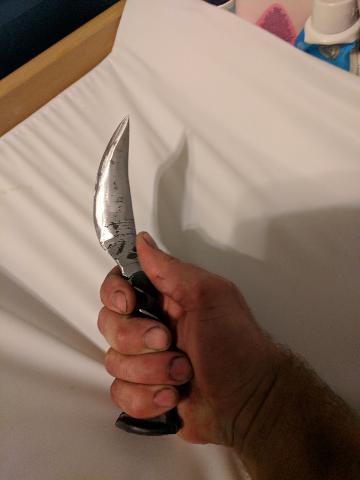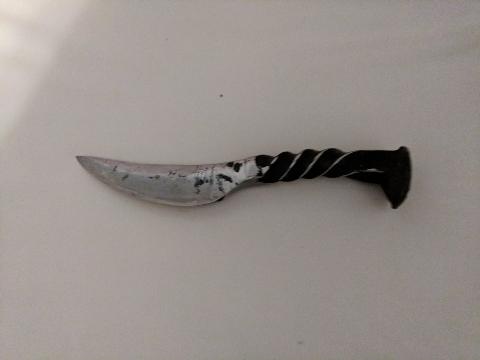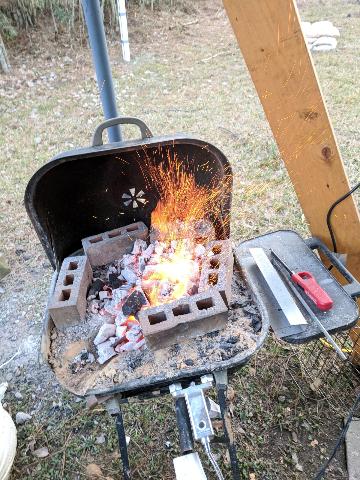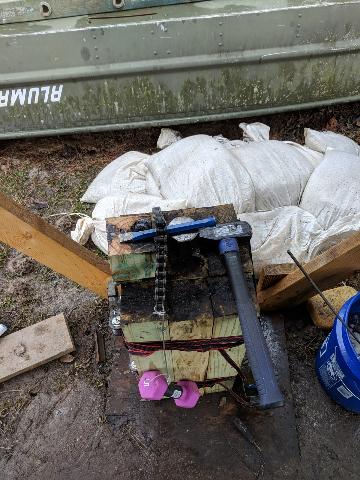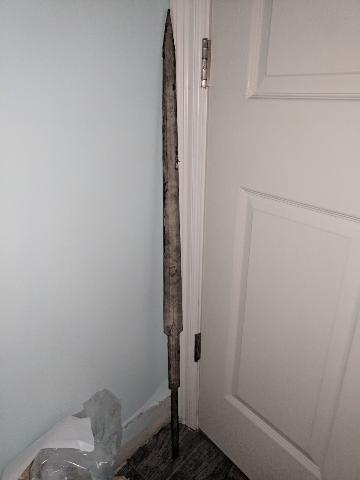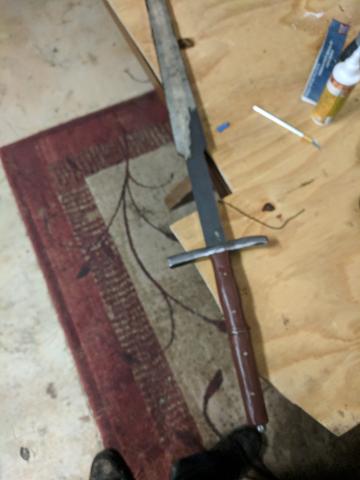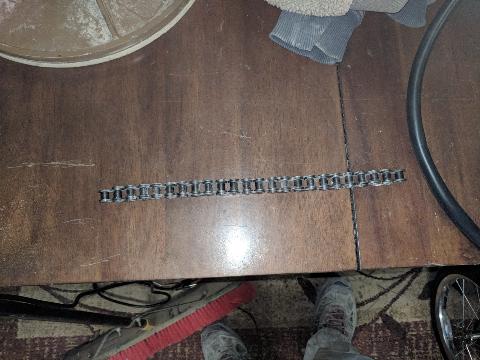
genesaika
Members-
Posts
180 -
Joined
-
Last visited
Content Type
Profiles
Forums
Articles
Gallery
Downloads
Events
Everything posted by genesaika
-
I was a bit worried about the edge retention, but it seems to have held up well enough. I was more interested in forging a blade than making a high quality piece, but it seems to have came out pretty good. I'll be putting a finer edge on it Wednesday or Thursday when my new belts come in and then I'll be putting it through it's paces to see what improvements I can make. I wasn't going for a skinning knife, just a nice curvey knife because that's my style. I honestly think this one might be a little too thick to work as a proper skinning knife.
-
So this is my first forged knife. I made it from a hc railroad spike, I bought 8 of them off of eBay, so I'm pretty sure I'm in the clear on it. Over all it went pretty good. I drew out the blade from about 2 inches and then rough shaped the edge and the curve of the blade. I twisted the handle, which had my go get a bigger pipe wrench to do, and got it all lined back up with the blade. Then I let it anneal for an hour before heat treat, got it up to non magnetic and dunked it into canola oil, slashing through the oil slowly. My file scatted across the blade all the way along it. My 1x30 belt grinder made pretty short work of cleaning it up and shaping the edge. I went from 50 to 80 to 120 grits and then ran it across a fine diamond sharpener. I want to buy some finer grit belts for my grinder and a leather stropping belt too, So I'll be going back to sharpening it up some more. I tested it by beating it on a chunk of 3/4 inch plywood and it held up well. Then it made short work of slicing up some cardboard and stabbing though my soda bottle. It's not shaving sharp yet, but I hope to fix that
-
Table/workbench space, how much do you need?
genesaika replied to bigb's topic in Building, Designing a Shop
I like to do draft work on my work bench so mine is 4 foot by 4 foot. It also has my drill press, bench grinder and vise mounted to it. I have a full range of the angles burned into the top of it too. -
Personally I hate gloves, dangerous little buggers. I've had hot slag pop up into my gloves while cutting the cable from a crane hoist, right in front of the owner no less. I'll tell you what, you can not get the gloves off fast enough and the dance you do is apparently pretty comical. Some of the worst job site injuries I have seen are from gloves. They burn and they get sucked into rotary tools and gears. It's nasty stuff. The only times I use gloves are for welding, o/a cutting, hazardous chemicals, and picking up sharp trash( like when I demo ceramic tile). For welding and cutting I put sleeves over the cuffs of the gloves. Another big problem I have with gloves is that you can't feel anything with them. I've had some serious close calls with loosing fingers because I had gloves on and couldn't feel the danger I was in.
-
I could be wrong, but my understanding is that you do not need a forge the full length of the piece to heat treat. You can pass the piece through the hot spot of a smaller forge, working it until the full length is at critical heat. I also believe that this would be a more traditional way of doing it anyway. Now obviously a full length oven or forge would be able to provide a more even heat, but it's also inefficient and not necessary.
-
Could you drift the main bar and then split the back of it. Then attach the two angled bars to each other. Then put the angled one into the opened drift off the main bar and forge weld the drift back together.
-
Brands and Blacksmithing advice?
genesaika replied to AggieBlacksmith's topic in Blacksmithing, General Discussion
Sorry it took me so long, I haven't been getting home until after 8 every night. Here is my anvil with a chain hold down and a support block. -
I like my hair dryer, keeps the fire hot and it's easy to control how much air I'm pushing. I can't say much about how long it will last, but mine is doing fine.
-
I would say yes, the optimal stroke is between 16 inches. Once you get past that the pressure will reduce, but it's not a huge decrease, I would say that your cylinder might get to 2500 psi at full stroke. As mentioned earlier though, it would be ideal to keep it below half stroke.
-
Yup, you will need a valve some plumbing and a control for it. On the plus side it looks to be in great shape and the wipper seal looks to be in good shape. Have you seen the ram? If not you can pull the plugs, pin the bottle side to something heavy, and pull out the ram. Look for any rust or dings, the entire ram should be clean and shiny or it will destroy the seals inside. Beyond that I would have to open it up to tell you more. If it were me I'd look at swapping that clevis for the bar side, because I prefer it that way, but it shouldn't make too much difference.
-
@MastaStan I have to ask, do you leave all of your handles as a scroll or simple wood? Anything more is just decoration and unnecessary. Honestly if basher wants to add a fancy description that's fine, it would have been nice to have some indication of it, but it's just another way to make your work stand out and give it a life. This is beautiful work, I enjoyed the whole thing. Petr Florianek has certainly done amazing work on the fittings.
-
The parts im talking about are external. Can you possibly provide a picture? I might be able to tell you more.
-
If it has sat idle for any extended period of time the seals can also be bad. Unless you can get a history on it I would get it inspected before putting it into use. Edit: if it has a port on either side then yes it is dual action. Usually they will have valves and plumbing between the ports.
-
I spent roughly 10 years as a heavy equipment mechanic specializing in all forms of cranes. While I can't help much with the design, I can answer your questions. 1) No it does not, infact fully extending them can cause damage to the seals. The design of your cylinder with determine it's effectiveness though. They have 2 common designs; one that releases pressure by draining the tube, and one that uses reverse pressure to push the fluid out, ideally you would want the later. 2) see the first answer 3) so long as you stay within the specs you should be fine. I have worked cylinders out of specifications and never seen one break, the specs usually allow for 10-25% overload. That being said a shorter stroke will allow for higher output. 4) I would have to agree with you. My suggestion would be to go over the seals, or have someone do it, and maybe add a guard to the side you will be on. As a side thought for you or anyone more knowledgeable, would it be possible to put the cylinder on the bottom? The anvil would have to be over-engineered and the whole frame would have to be well secured.
-
Brands and Blacksmithing advice?
genesaika replied to AggieBlacksmith's topic in Blacksmithing, General Discussion
Ok, so your piece of rail is longer than wide, that's nice for many reasons like stability and being able to tie things down. Keep in mind that you can only move as much metal as the face of your hammer, no matter how big your anvil is. Beyond that your anvil is shaped like an 'H', which is a very strong shape, but it has a lot of open air. So if you hit on one of the wings where it has air under the metal, you are actually hitting on a much smaller amount of weight, just what is directly under your hammer. Now if you turn the rail on end there is no open air under your hammer, just straight anvil mass. As needed you can use saw horses or other supports to help work longer pieces and allow you to tie things down as well. Later today I will post a picture of my 8# sledgehammer anvil with a support block that I added. -
If you want to use coal why not start with a JABOD. Easy to build, easy to maintain, and you will pick up the knowledge of fire control pretty quickly just from using it. I started mine with no knowledge of forging and now I can get forge welds, I've only got about a months worth of blacksmithing under my belt. Listen to the knowledgeable folks here and ask questions, they usually answer without much fuss.
-
Just a Tub of Dirt, photo heavy
genesaika replied to 4elements's topic in JABOD - Just A Box Of Dirt
I took some regular bricks and made a wall around mine. Works double duty blocking some wind and keeping my fuel in place. -
After my first all day forging I had radiant burns on my right arm from the forge. I'm pretty use to working in the sun so it wasn't too bad, but it probably means the forge is too close to the anvil.
-
So I'm not forging the blade, in the future I might heat treat it, but my goal is just to have a wall hanger that I can wear to ren fairs. The blade is 1/4 inch 1080 and the cross is 3/4 inch a36. I made the handle from some cheap wood, the spacer is stainless washers, and the pins are bronze brazing rods. I have been reluctant to post about this because honestly it isn't very good, but I've got tough skin, plus this is just a rough draft to get use to my tooling and the techniques. I'm already on my second draft of the cross and it's not complete, I plan on doing rubics twists on either side and then filling the cuts with bronze braze. My first attempt at the cross was with 1/2 inch and it gave me a hard time slitting and drifting to 1/4 inch. Also, I realize pins in a European style sword is a little odd, but I want it all to be changeable as I go. Anyways, here's some pics.
-
Why blacksmithing? initial pull
genesaika replied to Tock's topic in Blacksmithing, General Discussion
For whatever reason when I was a kid, 13-14 years old, I enjoyed the idea of being a blacksmith. At the time I had no support so my attempts didn't go so well. After many cold burning fires, broken cinder block anvils, and ruined pieces of metal; I gave up. I always wanted to get back to it, just didn't have the space, money, tools, or whatever excuse I made. I think my big draw was making weapons as a kid, but now it's more to express my artistic side and beat on metal. Naturally I still want to make weapons, but tools also intrigue me. I'll be honest, the one thing that really pushed me to getting started was watching the smiths on forged in fire. Seeing how some of them got by at home with little more than a chunk of steel and a fire, was inspiring. Plus I'm trying to stop using excuses, it's not easy. -
I use a hair dryer too and can definitely confirm that it will burn up your fuel like you have it set up. With the dryer loose you can angle it to get more or less air, adjusting the temperature. If I have been fiddling with some fitments or something and my fire gets cold I can turn it up to speed 2 and get it back to temp in a few seconds. My tuyere is pretty horizontal and I have had fire shoot out the end of it at least once. To be fair though I'm usually working on something while it's running, so I could have just not seen other instances.
-
That's roughly what I was thinking, though the hing is a really good addition. How much weight do you think I would need to make it work.
-
@JHCC I have read that thread, it's how I knew the chain would work well. My big problem is the 2" or 2-1/2" surface of my anvil, I'm thinking about using a block of wood to extend the face.
-
I was walking around the job site waiting for a delivery when I found this in the trash. It's about a foot of chain from a large roll up door. I'm planning to make a hold down with it once I figure out how to do that on my sledge hammer anvil haha.
-
After reading the first few posts I figured it was just about using bronze and later making it was mentioned, my mistake.
